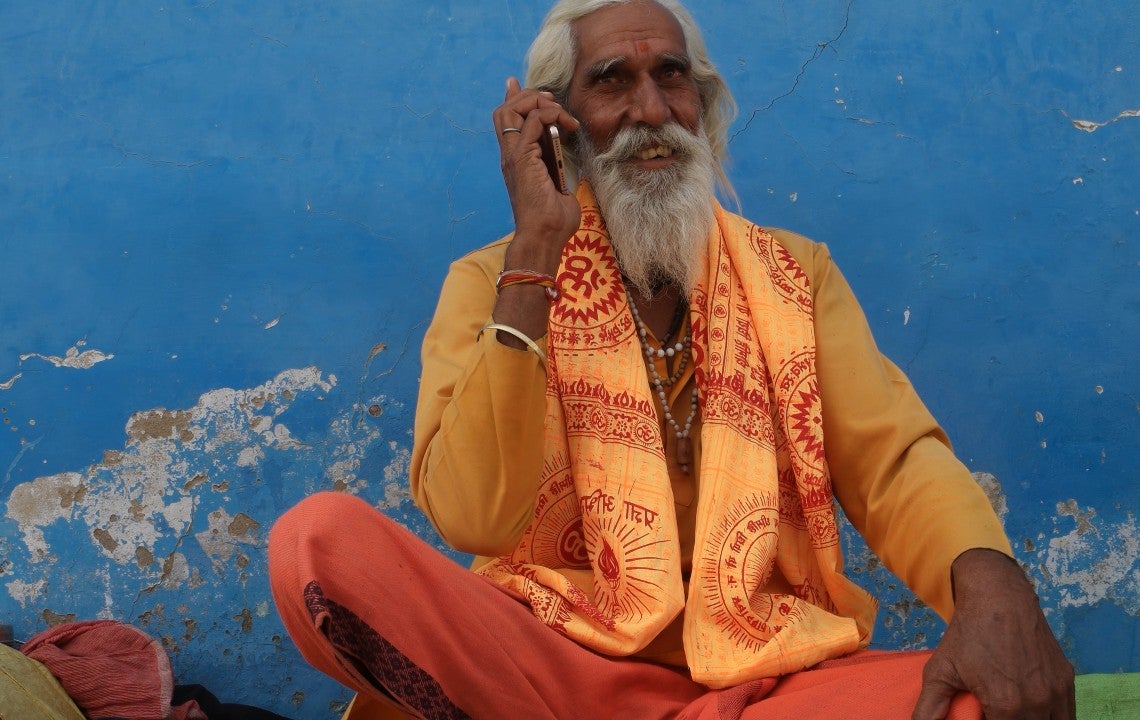 An old Indian monk talking on the phone
An old Indian monk talking on the phone
Does internet help you to stay in touch with family and friends? If you answered yes, you could claim that internet is benefiting your health! Scientific research has demonstrated that social isolation – often correlated with age – is a risk factor for premature death comparable to smoking, obesity, and physical inactivity. According to the UN, the share of individuals that are 65 years or older is increasing more rapidly than the population below that age.
Estimates indicate that this segment will account for 16 percent of the global population in 2050 (up from 10 percent in 2022), with the number of 60 and over who may face age-related disabilities expected to reach 2.1 billion. As the world goes digital, with everything from banking to healthcare and government services moving online, this trend raises new challenges for policymakers as older people tend to be less familiar with the internet. While we often talk about the digital divide across genders or urban and rural groups, the wide gap in internet use between generations is another crucial area of focus.
Today, nearly 70 percent of the global population over the age of 10 uses the internet. However, if we look at data more closely, people between the ages of 15 and 24 use it more compared to the rest of the population. For instance, in the USA, one of the most connected countries globally, around a quarter of people aged 65 and older are not online. In Brazil, almost half of the population over 60 has never used the internet.
In many cases, older people have spent much of their lives ‘offline,’ going to work in an office, handling financial matters at a brick-and-mortar bank or visiting friends in person, which means they may not have had the need or opportunity to develop digital skills. At the same time, a significant proportion of older people in developing countries often cannot afford devices and internet subscriptions. And despite the increasing call for digital skills, many older adults living with low income are unprepared for the digital world. This means that a segment of our society is being left behind when it comes to accessing basic services, social interactions, and economic opportunities.
It is important that older people can get online for a variety of reasons. There is a predominant social aspect underlying the internet that can be crucial to enhance seniors’ quality of life. Moreover, among this segment of the population, mobility may be limited. Hence, internet can facilitate access to a wide spectrum of resources, from signing up for public services to grocery delivery. Digital health could complement traditional healthcare services, for instance facilitating remote monitoring for an older person who lives alone. Access to good quality internet and digital public infrastructure is also key to increase resiliency during health shocks and promote social assistance response.
There are examples around the world of specific programs to bring the aged population online. For instance, the charity HelpAge in India promotes digital literacy and internet safety programs for the elderly, who may be more vulnerable to online fraud or scams. In Colombia, a program led by the government is working with the Universidad Nacional to strengthen seniors’ digital skills – for example teaching them how to use technology to access public information, carry out requests for services online or communicate with family and friends. Several mobile operators in different countries offer discounted internet subscriptions to older users.
The World Bank’s digital development team supports digital skills trainings as part of various projects around the globe, targeting the whole age spectrum. For instance, the Caribbean Regional Communications Infrastructure Program (CARCIP) in Nicaragua trained nearly 600 individuals over the age of 45 on foundational and more advanced digital skills, and about a third of them reported an increase in salary after six months of completing their training program.
Considering the global demographic shifts we are seeing and how quickly our everyday lives are moving online, it’s crucial to equip all with the skills to connect in a safe and meaningful way. Digital inclusion programs should follow a holistic approach so that everyone – young and old – can reap the benefits of the digital transformation. Digital skills programs, whether led by the government, academia, or the private sector, should target elders, focusing on their specific learning gaps and needs.
Public resources such as the universal service funds - a system of subsidies, fees, and funding designed to increase access to telecommunications resources - may be leveraged to support these activities as well. Digital public services should be designed considering the potentially limited digital skills available for this segment of people, promoting user-friendly interfaces while ensuring online safety. Finally, each of us can also play a role, encouraging senior citizens to get online in productive ways, from using online messaging applications to stay in touch to teaching them how to make the most of e-commerce platforms. Together we can help narrow the aged-based digital divide.


Join the Conversation